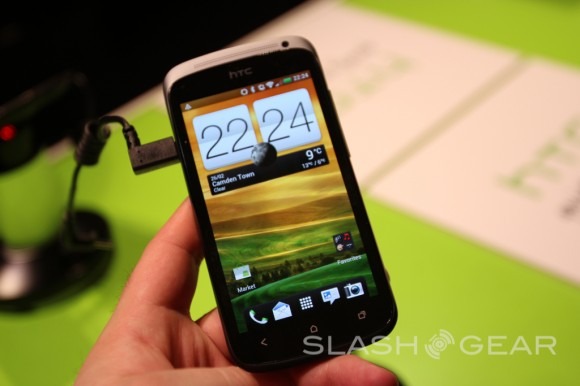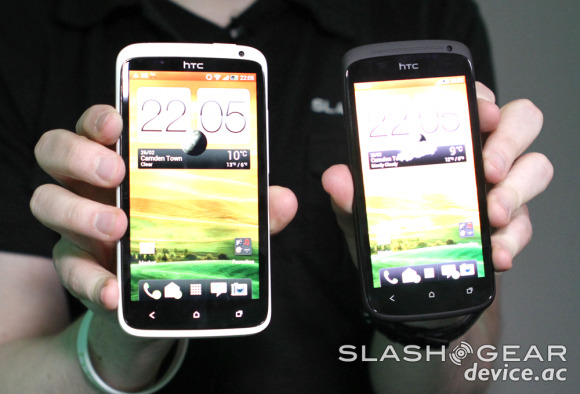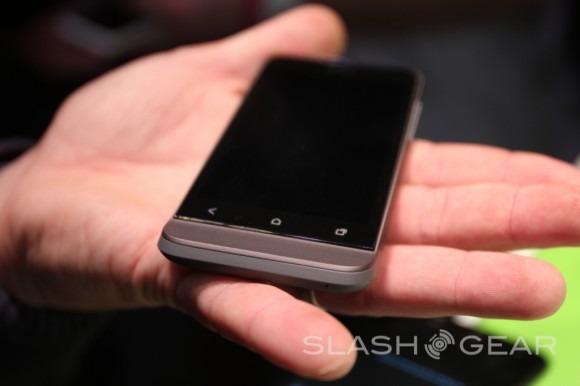HTC Mobile World Congress Wrap-Up
LG and Samsung have been dropping pre-Mobile World Congress hints all of last week, but it would be hard to argue against the fact that HTC has owned the opening night of Mobile World Congress. Their three-pronged HTC One line isn't just a new series of phones, it's a dividing line for the the company, signifying the beginning of a more centralized strategy and (hopefully) a clean break from their rather disappointing second half of 2011. They're hitting the high, middle and low end of the smartphone market with three extremely targeted models, all sharing the same design DNA. Naturally, SlashGear was there to cover it all.
All three phones feature the unibody all-in-one aluminum design introduced with the HTC Legend at Mobile World Congress 2010, and sorely missing from a large part of HTC's lineup since then. That's not the only thing they have in common: the three phones will be the first to come to market with HTC's Sense UI 4.0 running over Android 4.0 Ice Cream Sandwich, and all three will be using Beats audio, taking advantage of the partnership between the two companies. And all three have a focus (ba-dum tish) on the camera, with a F/2.0 lens, fast access and the ability to shoot full-resolution stills and HD video at the same time.

The flagship model, made with the intention of winning the hearts of gadget hounds everywhere. Like LG, HTC's built their highest-end device around Nvidia's Tegra 3 processor in its new 5-Plus-1 configuration, with the extra core designed to run when the phone is idling or at a low load. That's hardly the only thing to be excited about, though: the 4.7-inch 720p screen is as big as anything this side of the Galaxy Note, and though it's an LCD panel, HTC assures us that the Super LCD tech is just as good. That unibody design has a few drawbacks, though: a generous 1800mAh battery can't be removed, and the phone requires a pin, iPhone-style, to access the sliding SIM card tray. 32GB of storage should be enough for almost everyone, but those who need more are out of luck, since there's no MicroSD card slot. The rear camera is a full 8 megapixels, and combines with an F/2.0 lens and BSI sensor, should take some great stills.
The HTC One X is coming to America – but not in the same form that we saw today. AT&T will add LTE capability but swap the Nvidia Tegra 3 for a Qualcomm Snapdragon S4, a 1.5ghz dual-core processor.

The One S is the workhorse of HTC's new royal family, taking roughly the same market position as the Sensation last year. It'll keep the same anodized aluminum theme, but shrink the screen down to 4.3 inches, which seems to have become the median for Android these days. On the plus side, you get a true AMOLED screen, though the resolution is "just" 960x540. The One S is the slinkiest of HTC's new phones, with a body that tapers to just 7.9mm at its thinnest point – not a record breaker, but downright amazing for HTC's usually chunky designers. Processor is a dual-core 1.5Ghz model, likely the same Qualcomm S4 that the US One X is getting, and it's paired to 1GB of RAM. 32GB of storage and a lack of MicroSD card is present again, with a slightly smaller 1620mAh battery – also non-removable.
T-Mobile is getting the HTC One s first in the United States, and as far as we know, it's the same HSPA+ model we saw in Barcelona today. There's no word on when it will arrive or for how much.

The One V is the "budget" model of the One line, though frankly, it could hold its own against almost any of the high-end Android phones in the earlier part of 2011. A 3.7-inch screen running at 800x480 makes for a much tighter package, though it still uses the same unibody construction. HTC is also reviving the "chin" element seen on its early Android handsets. With a Super LCD and a 9.24mm profile, it's definitely a step below the One X and One S, but that solid construction is hard not to like in any case. The processor is downgraded to 1Ghz with just 512MB of RAM and a paltry 4GB of storage, with a smaller 5MP camera sensor (though it keeps the F/2.0 lens). Unlike the other two One models, the V lacks NFC capability, but makes up for it with an empty MicroSD card slot.
There's no pricing or availability info for the HTC One V, though it's likely to ship unlocked in Europe very soon.
And there you have it: HTC's hero phone strategy for the first half of 2012, and very likely extending into the fall as well. While variants of the three One models will probably be made for various markets (beginning with the One X in the US) these are likely to be the bread and butter for the Taiwanese company for the near future. What say you, readers? Are you convinced that HTC's designs have turned over a new leaf, or is it a case of too little, too late?
